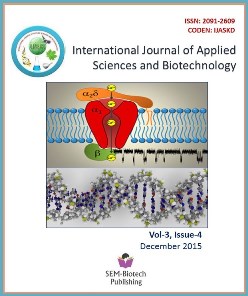An Assessment of Major Nutritional Components and Some Secondary Metabolites of In-Vitro Propagated Stevia Rebaudiana (Cultured in Bangladesh) Plant Leaves Dry Powder
DOI:
https://doi.org/10.3126/ijasbt.v3i4.13972Keywords:
Stevia rebaudiana, Nutrition, Mineral, Secondary MetabolitesAbstract
Stevia rebaudiana, belongs to the family of Asteraceae, is a perennial and medicinal shrub. It’s leaves dry powder widely used as a natural sweetener which has no calories but reported to be 50– 300 times sweetener as sweet as sugar, that are said to be having insulin balancing properties without any side effects. This research was first time conducted in Bangladesh where a quantitative analysis were performed for determining the major constituents of in vitro propagated Stevia rebaudiana plant leaves dry powder that was prepared through oven dry after sun dry. The analysis revealed the powder as mild acidic (PH 5.345). Total chlorophyll contents were found to be 0.845mg% where chlorophyll–a and -b were 0.088 and 0.761 mg% respectively. The major macro nutrients such as ash, crude fiber, total carbohydrate, total protein and fat were determined at the amount of 7.05, 10.5, 53.52, 13.13 and 3.55 gm% respectively where the micro nutrients like Iron (Fe), Sodium (Na), Potassium (K), Calcium (Ca), Magnesium (Mg), Phosphorus (P) and Chloride (Cl) were found at the amount of 34.2, 184.3, 2500, 534.43, 465.34, 304.7 and 49.6 mg% accordingly. Screening for secondary metabolites showed the presence of alkaloids, flavonoids, saponins and tannins as the amount of 2.83, 17.20, 6.69 and 5.84 mg% respectively in dry powder. These findings also have been compared with the other reported values on Stevia from different countries of the world.
Int J Appl Sci Biotechnol, Vol 3(4): 721-726




